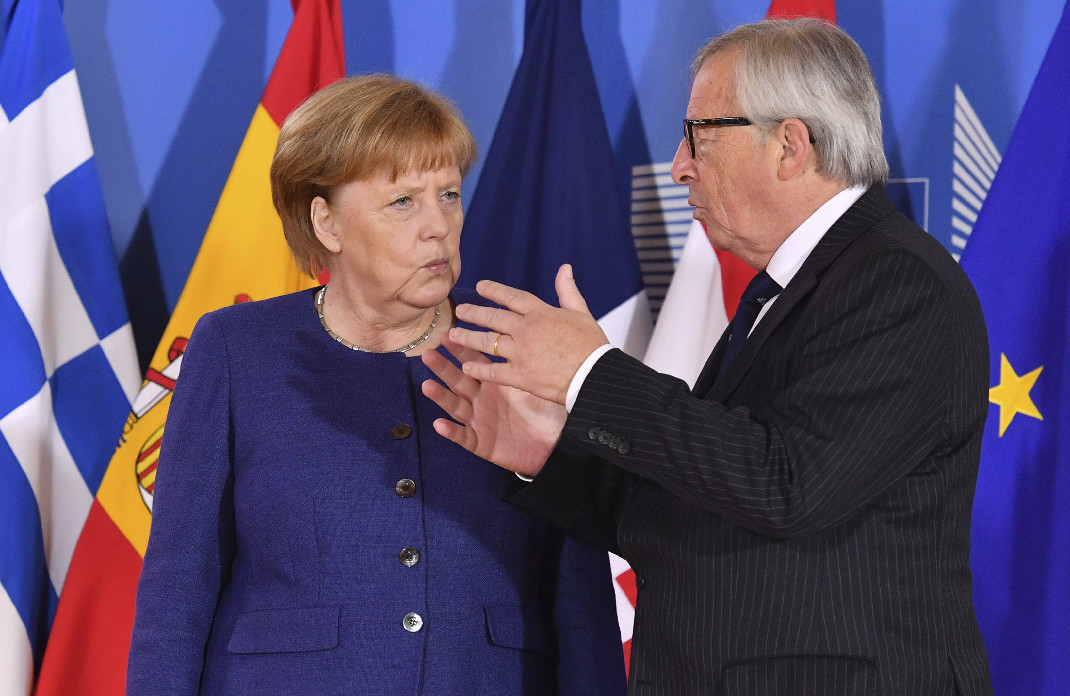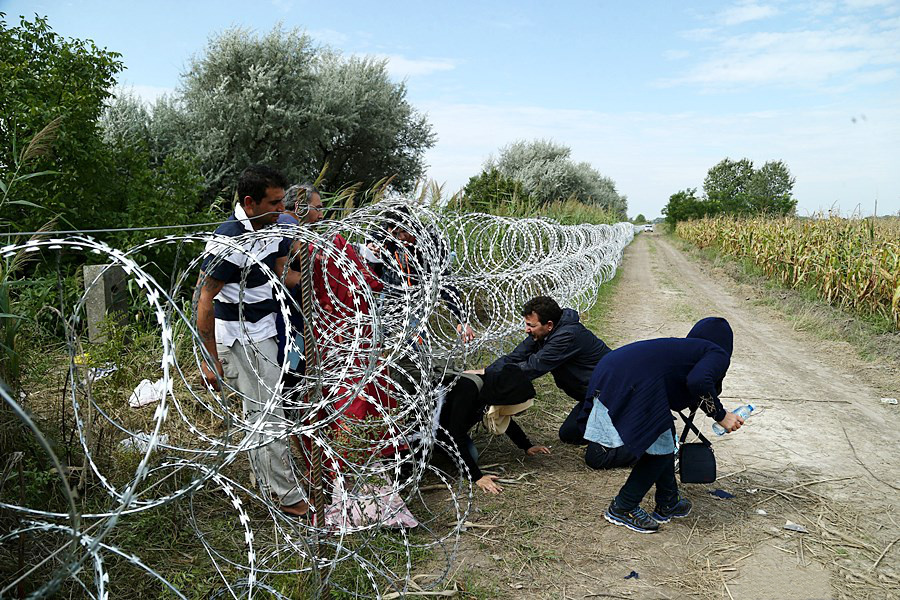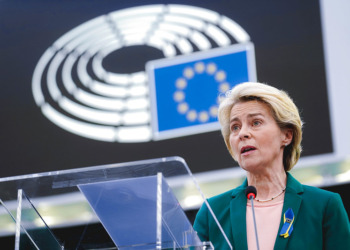At the recent European Council meeting, the highest level venue in the European Union with all 28 leaders in attendance (including the UK), it looked like the EU was about to break down over its migration problem.
No doubt to Trump’s delight. He’s been actively fighting the European Union which he has always seen as a threat to MAGA. On Twitter, he has regularly attacked Germany, most recently with fake data, claiming that migrants are the source for a rise in crime (that hasn’t happened – crime rates are at the lowest level ever as Der Spiegel was quick to note). Also, according to a recent Washington Post reconstruction of events, Trump even tried to convince Macron to take France out of the EU for a “substantial bilateral trade deal”.
It is in this context of America’s abrupt withdrawal of support to Europe and its institutions that the Europe’s migration problem must be placed. Fueled by European populist parties aligned on Trumpian anti-immigration and euro-skeptic policies, there is violent disagreement within the EU on how to address the problem.
Italy has always been, along with Greece and Spain, on the forefront of the migrant invasion, and for decades it has addressed the migrant challenge alone, with no help from Europe. With the new government in place, this has changed.
The vice-premier and interior minister, populist strongman Matteo Salvini, has made it clear to all EU members, declaring that Italy would “no longer be Europe’s refugee camp”. Migrant rescue ships run by NGOs are no longer allowed to dock in Italian ports:
This led to a spat with France two weeks ago, but eventually France and Germany (after a conciliatory call from Angela Merkel) agreed with Italy that there was a need to share the burden.
Salvini’s populist friends in Eastern Europe have also made it very clear that they won’t play the game. Austria and the Visegrad group of countries (Hungary, Poland, Czech Republic and Slovakia) led by Orban, Hungary’s autocratic Prime Minister – have steadfastly refused to cooperate with EU members and will not accept any migrants sent their way.
That was the situation before the European Council meeting: gridlock.
Angela Merkel was panic-stricken: Her own interior minister, Horst Seehofer of the Bavaria-based Christian Social Union (CSU), a major ally in the government coalition, sounded like his Italian friend Salvini, determined to turn away migrants at the border. This is understandable: the CSU faces elections in October and is aligning itself on anti-immigration lines in an attempt to draw votes away from the anti-migrants, rightist-populist Alternative for Germany, a rising rival, currently the third party in Germany.
Either Merkel would find a solution at the European Council, or Seehofer would dissolve the coalition and she would probably have to resign as Chancellor.
In the end, after two days of harrowing discussions (27-28 June), the breakdown didn’t happen, there was a “minimal” agreement that probably saved Merkel’s political career.
No doubt Donald Tusk, the President of the European Council, played a role in the relatively positive result. But, as he says, this is “not a success yet”, much will depend on what happens next, whether EU members follow suit:
As shown in the video, the European Commission President Jean Claude Juncker who talked right after Tusk confirmed (in German) that he would travel to Washington before the end of July to discuss trade issues between the US and the EU. And he made the point that the EU on trade, unlike on the migrant question, is “fully united”, concluding: “I am not sure that we will find an agreement between the US and the European Union, but we’ll try.”
The Migration Problem Is Politicized: Angela Merkel “on notice”
There are two problems here. One is that the public’s focus on migration is displacing needed attention on far more serious issues, like the Euro – a currency that is still missing one leg to walk, the fiscal one, that only a yet-to-be-agreed-on European Treasury could provide. Something Macron is pushing hard for but, because of the migration issue, he is finding himself sidetracked.
The other problem is that European populist parties in power, whether in Austria and Eastern Europe or now in Italy, have shifted the political discourse on migration with arguments that make it impossible to resolve. Their political strategy is clear: they know that their anti-immigration stance wins them votes. All they talk about is “defending national borders” from foreign “invaders” – exactly the same language Trump uses when he calls for strengthening US borders. A language designed to stir up age-old fears and hatred for the “other”.
The solutions proposed by populists are those of a police state: build walls and detention centers, lock up migrants and deport them. No positive measures are envisaged. They never talk of teaching migrants the host country’s language and customs or trying to find useful jobs for them to do.
In the photo: Migrants in Hungary, August 2015 Credit: Gémes Sándor/SzomSzed CC BY-SA 3.0
The concept of “integrating migrants” is systematically derided – based on the erroneous notion that the economic pie is static, that it never grows and the number of available jobs is fixed. If you let a migrant get a job, that’s a job a local won’t get. Therefore migrants who work do so at the expense of national employment. Populists point to migrants as the cause of unemployment.
None of this is true. The economic pie grows when migrants work, it doesn’t stay fixed nor does it shrink. That was why Angela Merkel had opened the doors to a million migrants in 2015: At the time, the German economy was steaming ahead full blast and could readily use extra manpower.
Where she made her mistake was to ignore (or minimize) the management difficulties of “integrating” migrants and the funding required. In other words, a fully funded migrant integration program needs to be set up. It takes considerable time and effort to teach migrants the basic things they need to know about their host country and launch them on a workable path to successful “integration”.
Consider the essential steps that must be taken:
(1) teach migrants German; knowledge of the local language is essential;
(2) apprise them of German customs and lifestyles; they need to know, accustom themselves and accept the ways of their host country;
(3) identify their specific skills and provide additional training if needed to make their skills fully operational; match them with job openings where they could be best employed;
(4) expel migrants who do not fulfill all the above three points, particularly those with no skills or no desire to be trained; send them back to their home country together with their family/dependents.
Populists, in particular Alternative for Germany, were quick to exploit the resulting chaos and people’s fears. And they still are. Yet, as the final European Council document (out on 28 June) noted, the migration threat is practically gone, 95% down compared to three years ago:
“…the number of detected illegal border crossings into the EU has been brought down by 95% from its peak in October 2015, even if flows have been picking up recently on the Eastern and Western Mediterranean routes.”
Why the European Council Agreement Won’t Work
The European Council agreement, on paper, sounds good:
- The burden of welcoming refugees would be “shared” by all EU members;
- “controlled centres” would be set up within the EU to accommodate them;
- “regional disembarkation platforms” would be set up to process migrants outside of Europe with a view to filter out refugees from economic migrants;
- and the EU would invest in strengthening its external borders.
But the truth is, this solves nothing.
Why won’t the EC agreement work? Because it calls for solving the migrants question “on a voluntary basis” – which means that any EU member who doesn’t want to take in refugees is free to slam the door shut. Much to the satisfaction of euro-skeptic, populist Austria and the Visegrad group (Hungary, Poland, Czech Republic and Slovakia).
The document is clear on this point:
“All the measures in the context of these controlled centres, including relocation and resettlement, will be on a voluntary basis, without prejudice to the Dublin reform” (italics added).
The “Dublin reform” is a reference to the Dublin Regulation that established the principle that the EU country where immigrants first arrived in was responsible for processing them. A principle Italy vigorously protested since it left it, along with Greece, alone in facing the hundreds of thousands of immigrants landing on its shores.
Point 11 of the document that deals with migrants already inside the EU makes clear that the Dublin Regulation is in fact still the operative principle:
“Concerning the situation internally in the EU, secondary movements of asylum seekers between Member States risk jeopardising the integrity of the Common European Asylum System and the Schengen acquis. Member States should take all necessary internal legislative and administrative measures to counter such movements and to closely cooperate amongst each other to that end.”
EU member states are called upon to “closely cooperate”. Obviously they won’t, since it is to be done on a “voluntary basis”.
By the week-end, Italians had realized that point 11 of the EC agreement meant Italy would get back from France and Germany some 70,000 migrants – those who had arrived in 2014-2015 and managed to escape out of Italy towards Northern Europe.
In short, this is a mess.
Not for everybody.
Turkey will continue to get funding, some €3 billion for the over 3 million migrants, mostly refugees from the Syrian war, that it is now holding. No doubt Erdogan is pleased.
Africa will also get a hand should it agree to set up “regional disembarkation platforms”. In fact, Africa will get more than management support and related funding (the target is €3 billion). It’s not just a matter of solving the migrant question. The EC agreement makes is clear that cooperation with Africa is to be taken to a higher level:
“This will not only require increased development funding but also steps towards creating a new framework enabling a substantial increase of private investment from both Africans and Europeans. Particular focus should be laid on education, health, infrastructure, innovation, good governance and women’s empowerment.”
But the document also makes it clear that Europe is far from having adopted a “common asylum” procedure. Reform of the Dublin Regulation is pushed into the future, to be “based on a balance of responsibility and solidarity”. Is Italy satisfied with that wording? Of course not. Vice-premier Salvini was quick to complain.
This is also deeply unsatisfactory for anyone who dreams of a united Europe upholding European “values”.
Yet it was enough to allow everyone to go home and cry victory. Italy felt it had made its point that “any immigrant who had arrived in Italy had arrived in Europe”, to use Italian Prime Minister Giuseppe Conte’s phrase. But the victory cry quickly died on Italian lips when it realized that it would get 70,000 migrants back.
Italy felt it had been played by Europe once again.
The only people who really won were the Visegrad group that wanted no solution to be found – especially no solution to the problem of the thousands, even millions of migrants already in Europe.
Angela Merkel’s “European” Solution to the Migration Problem
Germany, with the highest number of migrants as a result of Angela Merkel’s 2015 open-door asylum policy, is now ready for a reset.
On Friday night, following the European Council meeting, Merkel circulated to her government allies, including her interior minister Seehofer, a document she called the “European solution” to the migrant problem. The solution included “reception centers” to be set up in Germany where migrants would undergo an accelerated “asylum procedure”, as agreed to at the European Council, and bilateral agreements with 14 EU countries ready to take the migrants back.
Greece and Spain have agreed to take migrants back (those who had first landed on their shores). Others were Belgium, France, Denmark, Estonia, Finland, Lithuania, Latvia, Luxembourg, the Netherlands, Portugal and Sweden. But Italy and the Visegrad group of countries were not among them.
Merkel got support from Austria’s President Kurz (Austria is taking over the EU rotating presidency for the next six months) who said “our goal remains a joint European solution with orderly protection of the exterior borders, and centres in third countries. That way we can also preserve a Europe without internal borders.”
As I write, Seehofer is threatening to pull out of the government coalition. This is serious. If he leaves, Merkel, with only her own party, the CDU, would be left without a parliamentary majority. So far, the Euro is stable and, according to Bloomberg, investors are taking it in stride, expecting Merkel to hang on.
Update 3 July 2018: The break-up was averted last night and Seehofer agreed to the deal offered by Merkel, calling for the establishment of “transit centers”. These are to be set up at the German border to process asylum applications as quickly as possible. Refugees already registered in other EU states can be sent back on the basis of bilateral accords. Again, a “European” solution on a voluntary basis, i.e. dependent on the willingness of EU members to cooperate. The Euro immediately strengthened.
This solves the spat with Seehofer’s party, but it really doesn’t address the migration problem over the long run. Expect the migrant tragedy in Europe to have many more chapters.
What is required is a fully-funded migrant integration program, as outlined above. Canada is one of the countries that has gone furthest in that direction and has shown positive results, though it is currently overwhelmed by Trump’s anti-immigration policies. Italy, likewise, has shown some good results in spite of difficulties over the three decades since immigrants started to land on its shores. In fact, as reported on Impakter, Italy had quietly developed a ground-breaking model for what to do with refugees, thanks to the efforts of a few innovative town mayors.
But now, because of the populists, even in Italy, all the talk is about closing borders, not about what to do with refugees, and that is a shame.
EDITOR’S NOTE: THE OPINIONS EXPRESSED HERE BY IMPAKTER.COM COLUMNISTS ARE THEIR OWN, NOT THOSE OF IMPAKTER.COM
Featured Image: German Chancellor Angela Merkel and EU Commission President Juncker at informal EU summit meeting preparing for the European Council (24 June 2018). Credit: Geert Vanden Wijngaert/Pool via Reuters










